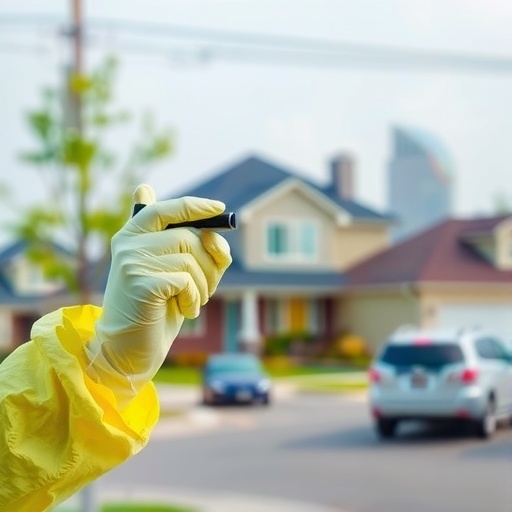In the pursuit of safer living environments, especially for children vulnerable to toxic exposures, researchers are continuously seeking innovative, accessible, and immediate diagnostic tools. Lead poisoning remains a persistent public health challenge globally, with lasting neurodevelopmental impacts, particularly in young children. Traditional methods for detecting lead contamination in residential settings have leaned heavily on specialized instruments like X-ray fluorescence (XRF) analyzers operated by certified technicians. However, the availability of such equipment remains limited, especially in underserved or resource-strapped areas. Addressing this critical gap, a new study recently published in the Journal of Exposure Science and Environmental Epidemiology explores the use of colorimetric surface wipes as an immediate, user-friendly method to gauge lead surface levels in homes and vehicles of construction workers exposed to lead, signaling a potential paradigm shift in environmental lead detection.
Lead, a pervasive heavy metal, is notoriously difficult to detect without elaborate instrumentation due to its low concentration in environmental samples and the varied contexts in which it can appear. Current standard practice for lead hazard investigations, especially in cases involving confirmed child poisoning, mandates trained personnel utilizing XRF devices to scan surfaces. While XRF analyzers provide accurate quantification of lead at various depths, their cost, bulkiness, and necessity for certified operators severely limit prompt assessment, delaying intervention efforts. Consequently, these delays may prolong children’s exposure to hazardous lead residues, undermining public health efforts aimed at mitigating lead poisoning risks.
This new investigation by Ceballos, Wu, Bermudez, and colleagues confronts these limitations by deploying colorimetric surface wipes that yield immediate visual feedback on lead presence. These wipes function based on chemical reactions involving lead ions, manifesting as a color change gradient from yellow to red. The intensity of the red coloration correlates with the concentration of lead on the surface sampled. Unlike laboratory-based quantitative assays or XRF analysis, these wipes offer an onsite, rapid preliminary assessment capability, which could accelerate decision-making processes for environmental health interventions.
The researchers meticulously tested the utility of these colorimetric wipes in real-world conditions focusing on homes and vehicles related to lead-exposed construction workers. This population remains at significant risk not only from occupational exposure but also from bringing lead dust into their living spaces and personal vehicles, inadvertently exposing family members. By sampling a variety of surfaces such as floors, windowsills, doors, and vehicle interiors, the study encompassed diverse contact points that could serve as vectors for lead dust transfer.
Their approach involved comparing the colorimetric wipe results against gold-standard XRF readings to validate accuracy and reliability. Encouragingly, findings indicated that the wipes performed well in correctly signaling lead presence, especially on surfaces with higher contamination levels. While not as precise as XRF data in quantifying exact microgram per square centimeter values, the wipes demonstrated high utility as a screening tool capable of informing the necessity for further comprehensive testing.
Colorimetric wipes hold several practical advantages that could revolutionize lead hazard assessments. First, their portability and ease of use mean that non-specialists, including parents, community health workers, or even construction supervisors, could perform initial screenings. This democratization of environmental lead monitoring could substantially increase screening coverage, particularly in low-income or rural communities where certified XRF technicians are scarce.
Moreover, the visual gradient from yellow to red offers users an intuitive interpretation of contamination levels without requiring technical training. Such immediate feedback facilitates prompt remediation actions, potentially preventing prolonged exposure scenarios. For example, a vivid red stain on a wipe could trigger urgent cleaning efforts, replacement of contaminated materials, or professional intervention. This rapid identification aligns well with public health goals of minimizing lead-induced harm before irreversible damage occurs.
However, the study also acknowledges the limitations of colorimetric wipes. Their sensitivity varies with environmental factors, surface types, and lead compounds present, which may influence color intensity and thus interpretation accuracy. The authors emphasize that these wipes should complement, not replace, comprehensive diagnostic tools but could serve as an effective preliminary screening step. This stepwise approach ensures resource optimization, reserving expensive and time-consuming XRF analyses for locations flagged by initial wipe testing.
In addition to residential environments, this research draws attention to vehicle interiors as a notable reservoir for lead exposure risk among construction workers. Lead dust can accumulate on vehicle seats, dashboards, and surfaces, representing a less recognized but potentially significant exposure pathway. The ability of colorimetric wipes to detect contamination in such microenvironments underscores their versatility and broad applicability.
This innovation arrives at a crucial juncture as public health agencies worldwide seek scalable strategies to combat lead poisoning amid persistent economic and logistical constraints. The global burden of lead exposure remains unacceptably high, disproportionately affecting marginalized populations. Tools that facilitate rapid, accessible screening empower communities and enhance surveillance systems, creating opportunities for earlier intervention.
Future work suggested by the authors involves optimizing the chemical reagents to enhance sensitivity and specificity across a wider range of environmental matrices. Additionally, integrating the wipe data with mobile phone applications leveraging image analytics could standardize color interpretation, reducing subjectivity and expanding usability. Such digital augmentation may enable real-time data uploading to public health databases, improving spatial lead exposure mapping and enabling targeted response strategies.
The implications of this study transcend mere methodological advancement. By harnessing an inexpensive, immediate diagnostic tool, the potential exists to weave lead detection tightly into community health practices, from schools and clinics to workplaces and homes. Such grassroots empowerment may transform previously passive populations into active participants in environmental health defense.
In conclusion, the study by Ceballos et al. presents compelling evidence that colorimetric surface wipes can serve as an effective, accessible adjunct to traditional lead detection methods. While not supplanting the precision of XRF analyzers, these wipes provide an invaluable frontline tool capable of identifying lead contamination swiftly and intuitively. Deployed widely, they promise to accelerate interventions, reduce ongoing exposures, and ultimately contribute to the global effort to eliminate childhood lead poisoning. This breakthrough opens the door to reimagined lead hazard management where science, technology, and community engagement converge for healthier environments.
Subject of Research:
Evaluation of colorimetric surface wipes as a rapid screening tool to detect lead contamination in residential and vehicular environments associated with construction workers exposed to lead.
Article Title:
Using colorimetric wipes to characterize lead surface levels in lead-exposed construction workers’ homes and vehicles
Article References:
Ceballos, D.M., Wu, Y., Bermudez, M. et al. Using colorimetric wipes to characterize lead surface levels in lead-exposed construction workers’ homes and vehicles. J Expo Sci Environ Epidemiol (2025). https://doi.org/10.1038/s41370-025-00818-7
Image Credits: AI Generated
DOI: 22 November 2025
Tags: accessible environmental testingaddressing lead hazards in underserved communitiescolorimetric lead detectionenvironmental epidemiology researchinnovative diagnostic tools for leadlead exposure in construction workerslead poisoning in childrenneurodevelopmental impacts of leadpublic health and safetyresidential lead contamination assessmentsurface wipes for lead detectionuser-friendly lead testing methods





